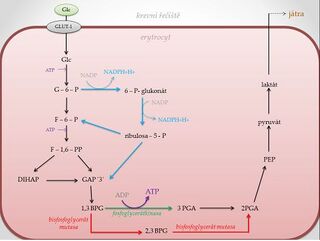Metabolism of erythrocyte
The main function of erythrocytes is to transport oxygen to tissues. Therefore, the structure and metabolism of erythrocytes are adapted to this function. Erythrocyte metabolism is unique due to the absence of mitochondria. Therefore, they cannot generate ATP by oxidative phosphorylation. The energy source for the erythrocyte is D-glucose'. Red blood cells, along with brain cells, are therefore the only cells in the human body that require a continuous supply of glucose. The glucose transporter in the erythrocyte membrane - GLUT-1' contains 12 transmembrane helical segments that create a channel for the passage of glucose in the membrane. The transporter is not dependent on insulin.
Anaerobic glycolysis[edit | edit source]
The basic metabolic process taking place in the erythrocyte is anaerobic glycolysis with the formation of ATP by substrate phosphorylation. Glycolysis in the erythrocyte proceeds similarly to that in other cells, but differs in the reaction catalyzed by phosphoglycerate kinase. If the erythrocyte does not need as much ATP, then 1,3-bisphosphoglycerate is short-circuited to 2,3-bisphosphoglycerate. The reaction is catalyzed by the enzyme bisphosphoglycerate mutase. The importance of 2,3-bisphosphoglycerate for erythrocytes lies in the function of hemoglobin. 2,3-bisphosphoglycerate binds to deoxyhemoglobin, which stabilizes and facilitates the release of oxygen in the tissues. The erythrocyte does not have mitochondria, so it gets rid of lactate. )
Pentose phosphate pathway[edit | edit source]
About 5% of glucose is used for the pentose phosphate pathway, in which the reduced form of the coenzyme NADPH+H+ is formed. The latter functions as a coenzyme of glutathione reductase, an enzyme necessary for the synthesis of reduced glutathione. Reduced glutathione protects the erythrocyte from the toxic effects of oxidative stress.
Hemoglobin[edit | edit source]
The main function of hemoglobin in erythrocytes is primarily oxygen transport. It also transports CO2 and is an important blood buffer. Hemoglobin consists of four subunits, each containing one heme. Heme is mainly synthesized in the bone marrow and liver.
Erythrocyte membrane[edit | edit source]
The erythrocyte membrane is composed of ten main proteins, which can be divided into two groups:
- integral - glycophorins, anion-exchange proteins
- peripheral - spectrin, ankyrin, actin
Glycophorins are glycoproteins that have their N-terminus protruding above the surface of the erythrocyte. Anion exchange proteins create a channel in the membrane to mediate the exchange of Cl- and HCO3- ions. Spectrins, ankyrin and other peripheral proteins are responsible for maintaining the shape of the erythrocyte.
Erythropoiesis[edit | edit source]
The formation of red blood cells is controlled by the glycoprotein erythropoietin. Erythropoietin is synthesized in the kidneys, from where it is released into the bloodstream during hypoxia, where it is transported to the bone marrow. Here it binds to the membrane receptor of erythrocyte progenitors.
Links[edit | edit source]
Related Articles[edit | edit source]
References[edit | edit source]
- {{#switch: book
|book =
Incomplete publication citation. , et alPrague : Karolinum, 2009. 269 s. 978-80-7262-438-6.
|collection =
Incomplete citation of contribution in proceedings. , et al. Prague : Karolinum, 2009. 269 s. {{
#if: 978-80-246-1416-8 |978-80-7262-438-6} }
|article =
Incomplete article citation. , et al. 2009, year 2009,
|web =
Incomplete site citation. , et al. Karolinum, ©2009.
|cd =
Incomplete carrier citation. , et al. Karolinum, ©2009.
|db =
Incomplete database citation. Karolinum, ©2009.
|corporate_literature =
Incomplete citation of company literature. , et al. Prague : Karolinum, 2009. 269 s. 978-80-7262-438-6} }
- {{#switch: book
|book =
Incomplete publication citation. MATOUŠ, Bohuslav, et al. Basics of medical chemistry and biochemistry. Prague : Galen, 2010. 0 s. 2010; 978-80-7262-438-6.
|collection =
Incomplete citation of contribution in proceedings. MATOUŠ, Bohuslav, et al. Basics of medical chemistry and biochemistry. Prague : Galen, 2010. 0 s. 2010; {{
#if: 978-80-7262-702-8 |978-80-7262-438-6} }
|article =
Incomplete article citation. MATOUŠ, Bohuslav, et al. 2010, year 2010,
|web =
Incomplete site citation. MATOUŠ, Bohuslav, et al. Galen, ©2010.
|cd =
Incomplete carrier citation. MATOUŠ, Bohuslav, et al. Galen, ©2010.
|db =
Incomplete database citation. Galen, ©2010.
|corporate_literature =
MATOUŠ, Bohuslav, et al. Basics of medical chemistry and biochemistry. Prague : Galen, 2010. 0 s. 2010; 978-80-7262-438-6} }
- {{#switch: book
|book =
SILBERNAGL, Stefan and Agamemnon DESPOPOULOS. Atlas of Human Physiology : 186 color boards. {{{issue}}} issue. Prague : Grada, 2004. 978-80-7262-438-6.
|collection =
SILBERNAGL, Stefan and Agamemnon DESPOPOULOS. Atlas of Human Physiology : 186 color boards. 62011. release. Prague : Grada, 2004. {{
#if: 978-80-247-0630-6 |978-80-7262-438-6} }
|article =
Incomplete article citation. SILBERNAGL, Stefan and Agamemnon DESPOPOULOS. 2004, year 2004,
|web =
Incomplete site citation. SILBERNAGL, Stefan and Agamemnon DESPOPOULOS. Grada, ©2004.
|cd =
Incomplete carrier citation. SILBERNAGL, Stefan and Agamemnon DESPOPOULOS. Grada, ©2004.
|db =
Incomplete database citation. Grada, ©2004.
|corporate_literature =
SILBERNAGL, Stefan and Agamemnon DESPOPOULOS. Atlas of Human Physiology : 186 color boards. 62011. release. Prague : Grada, 2004. 978-80-7262-438-6} }


